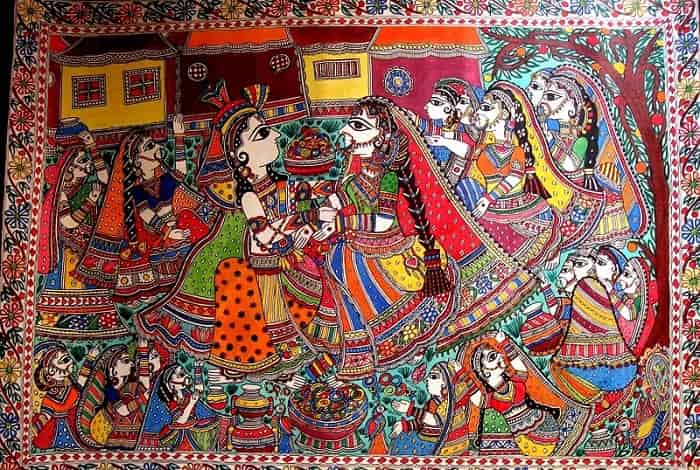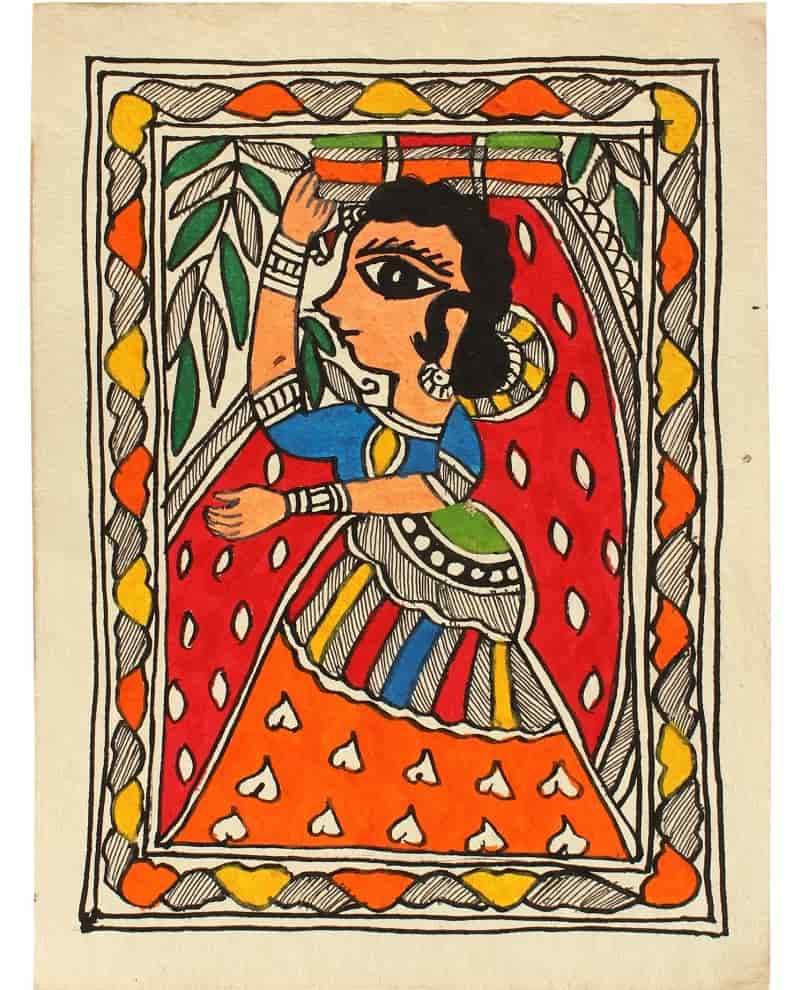- Region: Bihar
- Forms of: Mythical
- Special Feature: Created By Mithila’s women
- Variety of Colors: Regional flower’s juice
Bihar is a very cultural and traditional state of India, from ancient times they give respect to their traditional customs and religious beliefs. You can observe it through many things their lifestyle, festivals, beliefs, costumes and their art. This state is not just religious or spiritual but it is also artistic, through their artistic thoughts and creativity they try to display their daily life in a very colorful and interesting way, which is amazing and beautiful. Your first see the Mithila painting of Bihar which would create lots of interest in your mind, and it would definitely impress you. This art work is majorly practiced in Bihar’s Mithila region. After seeing the exquisite art work of Mithila, you will think that artists are not just creating any picture or shape; they are playing with a number of colors.

The entire creative work and detailed work left the impression, that it is surely made by any excellent and expert artist, but it is a talent of Bihar’s rural women. Because they are living in this land from their birth and they know it’s touch so well that they try to express and publicize it through their art, which they haven’t learn from any art institute or any organization, they have learnt it from their old generation. Through Mithila paintings, you will get to know the vibrant and bright flavor of folk life. The fragrance of this beautiful art flower has spread till International market, and from many nations; Mihtila paintings have got a huge demand; now you must have been too excited to see this form of art and craft that has been born in a very small state but has reached across the world.
From the richness and royalty of this art, you would get an idea that this art form is very old, so Mithila painting art was born during Lord Rama’s period. In fact, during that time this art was used to adorn the hut’s mud walls. In this 21st century, it has come on cloth, paper and canvas. During your Bihar trip, don’t forget to visit town region, because there you will get to see the Mithila paining, especially in Madhubani, here you will be surely surprised to see the 3 dimensional pictures which have been created on Paper with the help of herbal colors. If you are planning to visit this state, then try to explore it during religious or festival occasions to practice a huge view of this real image of Bihar state. You will surely won’t able to control your heart from staying away from shopping after seeing such a multi-coloured dynamic art. You won’t get a chance to see such a pure and rich art in developed cities, because purity is left only in rural regions, where you will get to see the real India.

The Government emporia are helping the regional artists to present their art within cities, which would financial help them and encourage them to create more and more beautiful and marvelous work. As per local folklore, the actual origin of Mithila printing belongs to King Janak; as per them King used to call artists to make paintings on the occasion of Devi Sita’s wedding. In the magnum opus, Great Tulsidas has explained the entire scenario of Sita’s wedding, in that he has mentioned about the Mithila painting. This painting is a best example of purity, because artists make it by using pure elements, the colors they use for painting are derived from plants. The colors which are used by artists in huge amount are green, red, and yellow. If you observe the Mithila painting in detail, you will get to know that through the paintings regional artists majorly showcase mythological event, nature, various themes that belongs to Hindu gods such as Shiva, Krishna, Durga, Ram and Kali etc. huge numbers of these form of painting has been presented in various corners of the world.
Originally, the art of Mithila painting is performed through women of various communities and castes of Bihar region. Since old times, women of Bihar have been involved in this art form. Through their artistic thoughts, you can see the relationship within culture, nature & human psyche. To create Mithila painting, they use raw materials which are present in their region in ample amount. Like developed cities, regional people don’t have many facilities to enjoy their life, to entertain themselves, art is the single source to put colors in their life. By folk painting and many more art forms, they get dreams, desires and expectations. They are illiterate, but still their thoughts towards nature, culture and social life are very open and bright.
At present, Mithila Paintings are created through female artists in 3 forms on the wall, on floor and on shiftable objects. In the first form, Aripan, is created on the floor by the help of Arva paste or it is also called as curd rice. In local language, the paste of rice is called as Pithaar. Despite from floor, Mithila painting is also made in leaves of banana, on wooden seats or peedhi. The regional girl or women create this printing by using their fingertips of their right hand. On the auspicious occasion of Tusari puja, single girls rejoice, and through this religious puja they worship Goddess Parvati and Lord Shiva to get a good life partner. In that festival, they make aripan, by using white rice powder, red and yellow colors. As per the occasion, the type of Aripan differs. The prime varieties of Aripan are daspata, Atadala, Swastika, Sarvatob-hadra. The wall paintings, the artists of Mithila painting are multi-coloured; in one wall painting usually they use 3 to 4 colors. The image of painting contains trees, fish and fruit trees like mango and peacock, parrot. They adorn the painting by creating amazing flower designs on 3 sides of painting. Mithila painting on moveable objects includes clay sculptures like elephants, pots, mat, birds, fan, bamboo and sikki objects. The noticeable and impressive designs created on the bride’s face come under the same category.
Mithila painting came over canvas or paper during the early 20th century; few females were requested to showcase their talent over canvas or paper for market. They have accepted and they got huge response. Their talent has been spread within various corners of the world. Right now, the Mithila painting is present on dress materials and greeting cards. The unique animal figures, human images, electrified manes, historical Cretan pottery, fresh colors and many more interesting and impressive elements have approached the world’s audience. The bright colors create mood and that’s why it plays a very important role in this art. For example, Passion and energy is expressed by the colors like yellow and red, binding force and dedicated energy is perfectly explained through red, where as green color tells about vegetation and natural leaves.
The moment, the colors of Mithila painting is ready, the artist uses 2 types of brushes, one is for detail, which is generally made by bamboo twigs, and the second brush is used to fill some specific spaces of painting which are made by tiny piece of fabric, that tiny cloth is connected to the twig. During the starting days, the colors were natural, which artists made using plant’s extracts such as flower, neem, henna leaves, bougainvillea etc. all these natural extracts were mixed in resin, which was gained through normal gum and leaves of banana, so that the colors could stick to the painting. At that time, these natural colors were cheap but it was taking a lot of time, even after spending so much time artists were getting less output than what they required. The artists found one solution to this problem; they decided to shift to synthetic colors, because it was available in ample amount in the market. At present, colors are available in the form of powder, and the artists mix it with goat`s milk before painting.
- Also Read: Popular Painting Styles of Haryana


